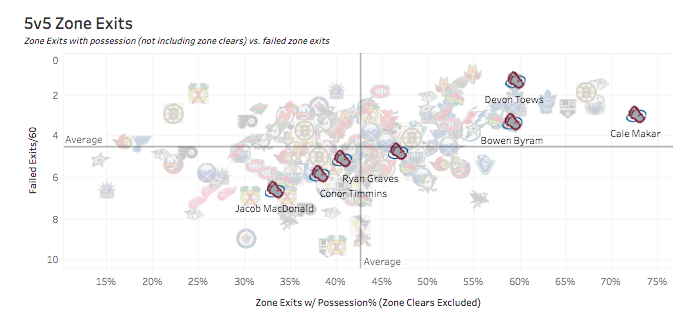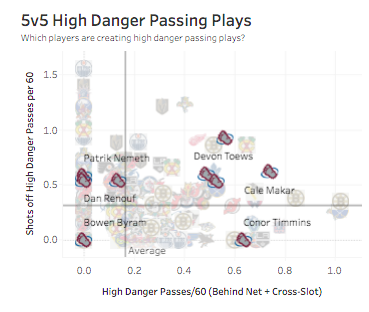Although most would consider Cale Makar of the Colorado Avalanche one of the NHL’s best defensemen – by whichever definition they abide – he may not rank first within every list. Physically speaking, Makar is anything but imposing, but the third-year blueliner compensates for his lack of brawn with an uncanny ability to effortlessly dictate play unlike the vast majority of his positional peers. This seeps into his defensive responsibilities and establishes him as more than an offensive specialist. Although he has yet to be named a Norris Trophy winner, Makar inhabits a stratosphere reserved for those who exemplify the pinnacle of the defensive position. What follows is a comprehensive evaluation of Makar’s impact across all facets of the game – play-driving, production, and chance quality- and shot-suppression. Let’s dig in.
The NHL’s Premier Blue-Line Playmaker
The only modern defenseman who approaches Makar’s level of complete domination with the puck is Nashville’s Roman Josi, mostly because he’s further along in his own distinguished career. In trying to assign Makar a positional label, we risk restricting the influence he exerts through his unparalleled command of on-ice events. He refuses to abide by historical notions of how a defensemen should behave, and embodies the NHL’s emerging trend of creating dynamic defensemen capable of singlehandedly dominating play through their skating and stick-handling.

In seamlessly maneuvering across zones and functioning as the lead engineer of the NHL’s most potent attack, Makar separates himself from the pack. Although he may not lead in every single offensive category, no other defenseman features in the top three for every meaningful statistic. His overall impact across all facets of attacking play is unmatched, and he transforms into a fourth forward when the Avalanche control possession, jumpstarting the offence.
Avalanche’s King of Controlled Zone Entries
Completing clean zone entries while retaining possession of the puck is one of the most underrated methods of creating offensive opportunities. The alternative – dumping the puck in – unnecessarily relinquishes the puck and instigates an uncertain 50/50 battle for possession. Why willingly give up the puck when maintaining possession in formation would be a more efficient use of finite game-time and energy? Using the legendary Soviet Union hockey system as an example, recycling possession until an opportunity to strike presents itself is a calculated method to generate higher-quality looks while retaining control of the flow of play.
If you browse the list of players who lead the league in facilitating clean zone entries and exits with possession (i.e. not dumping it in or out), a common theme emerges. The ability to consistently evade oncoming forecheckers and neutral zone traps is the leading factor in completing a successful entry or exit without conceding possession in the process. Makar is blessed with smooth skating resembling that of a figure skater, abruptly changing direction and rapidly accelerating with the ease of reclining on a sofa. Without the gift of telepathy, trying to slow down the Avalanche rearguard is like being locked in a darkened chamber with a feral animal – you’re vulnerable, and he smells blood.
While comparing the proportion of completed zone entries is useful to gauge general efficiency, the results are lent greater credence when factoring in a player’s overall workload. It’s more difficult to maintain strong results when your team leans on you to orchestrate entries every time down the ice. In terms of total zone entries completed per 60 minutes, Makar ranks second only to Josi. Further, Makar’s ability to maintain possession is incredibly crucial to Colorado’s gameplan, as entering the offensive zone with speed makes it difficult for opposing defences to set up their defensive scheme. Of his completed entries (including dump-ins) just under 50% of Makar’s total are executed with control of the puck, a rate which places him in the upper 10% of the league. Try to stop him at your own peril.
Colorado’s Zone Exit Magician
Moving on to zone exits, it is readily apparent how difficult Makar is to pin in his own zone. Generating exits with possession performs two crucial functions – starting a team’s breakout, and transporting the puck away from your own net. For a team which feasts on creating numerous odd-man rushes and quick counterattacks, Makar’s peerless skills are the key to maintaining one of the league’s most menacing attacks.
Related: Avalanche’s Makar Already on Hall of Fame Path
In a similar vein to zone entries, exiting the defensive side of the ice while keeping the puck allows a team to control what happens next, as opposed to dumping the puck out and retreating to face continuous waves of assault. In most cases, dumping the puck out exhibits a lack of creativity and confidence in one’s abilities. While being aware of limitations of the team’s personnel is beneficial in fashioning a strategy which plays upon their strengths, relinquishing the puck simultaneously reduces how much influence a team can wield over an outcome.
In terms of completing zone exits with possession, no other defenseman is more efficient than Makar. His 73% completion rate in 2020-21 was four percent higher than second best – and this article’s familiar adversary – Roman Josi. There’s no other way to put it, Makar is a wizard. He teleports from zone to zone with no strategy able to consistently hinder his efforts. If he wants the puck to end up in a certain spot, it’ll get there one way or another.

When a team wields as many transitional weapons as the Avalanche – Nathan MacKinnon, Devon Toews, and Samuel Girard all rank highly in the aforementioned categories – it’s almost impossible to overcome. Colorado relies on rush offense to systematically dismantle their opposition, ranking in the top five in terms of chances created off of zone entries (first) and the proportion of their entries which occur by carrying the puck in with possession (fourth). Miraculously neutralize one option and another three sprout in its place. A comprehensive victory can be accomplished – look at how the Vegas Golden Knights relentlessly forechecked in their series win last postseason – but it’s extraordinarily tricky, and Makar is the figurehead of the attack.
Makar Is the NHL’s Top Quarterback
It’s one thing to complete a controlled zone entry, and another to create a scoring chance upon doing so. Assists and points work to link the disconnected nuggets that are micro-stats, illustrating whether excellence in one aspect of the game leads to results where it matters – on the scoresheet.
Although all assists are assigned an identical point value, they are not all created equal. Secondary assists can be awarded to players who may not have been directly involved in a scoring play. Primary assists can (and do) suffer from similar issues, but it’s more likely that a player providing the final pass before a goal has had a greater influence on the outcome than someone who may have last touched the puck all the way back in the defensive zone.
That being said, Makar has created primary assists at the fourth highest rate since 2019, with only Ryan Ellis, John Carlson, and Aaron Ekblad exceeding his production at five-on-five. When factoring in his goal scoring and secondary assists, Makar climbs further up the leaderboard, placing second only to Carlson across the same time span. His point totals are partially a byproduct of his heralded teammates, but his peers skate alongside several of the NHL’s premier offensive talents – it’s not a situation that’s unique to Makar.
To filter through the noise, the underlying results driving point totals reveal which player most often contributes to his own success, rather than reaping the rewards of potentially unsustainable shooting luck or having the good fortune of facing a weaker goaltender. The rate at which a player generates high-danger passes (those originating from behind the net or moving across the slot) or shot-assists (those directly leading to a shot on goal) can illuminate who is most often setting up their teammates for success, rather than relying on whether or not they score to be rewarded with an assist. Sometimes a teammate is unable to convert, or a goalie rides a hot streak; strong playmakers shouldn’t be penalized for external factors that are not connected to their ability to complete high-leverage passes.

In facilitating 0.74 high-danger passes per-60-minutes, Makar posted the sixth highest rate last season, and the fifth most shot-assists among NHL defenseman. The young defenseman is clearly adept at consistently creating dangerous opportunities for his teammates, and significantly better than several defensemen who are considered to be the NHL’s best. If you’re betting on which player is more likely to continue replicating their extremely high levels of production, the logical gamble is choosing the one who finds themselves in advantageous situations more often than others.
Although Makar’s transitional and passing excellence is rightfully praised, he has the finishing talent to match, making him a truly fearsome dual threat from the blue line. Think of him as an NFL quarterback who can pair aerial dominance with an aggressive ground game, or Shaq if he hit free throws. Inter-sport comparisons aside, Makar is a versatile offensive machine with no glaring weaknesses.
In the past two seasons, Makar has scored the 10th most goals per 60 minutes at five-on-five while generating the 24th highest individual expected goal rate, which illustrates the quality of chances generated by an individual’s own shot. The threat of his incisive passing creates additional room in the offensive zone, forcing defenders to choose between neutralizing Makar’s passing targets or allowing him to roam into the slot uncontested. There’s no preferable alternative as one’s demise is guaranteed, but how it occurs is yet to be determined.
Related: 2021-22 Colorado Avalanche Season Preview Section
Makar faces stiff competition for the title of the NHL’s best defensemen, but his impact at both ends of the ice elevates him above the field. Many of his peers are porous defensively, essentially giving away the chances and goals they’ve created in the offensive zone for what ends up as a neutral net-impact. He may not accomplish those results while looking like Chris Pronger in his prime, but he’s effective enough to avoid cratering his defensive results. The most unnerving aspect of Makar’s game (for opponents anyway) is that he’s about to turn 23. What is already a formidable product has more room to grow. What he becomes in his prime could well be one of the most dominant defensemen to ever suit up for an NHL game. For now, he’ll settle for the title of the league’s best defensemen.
Makar’s Defensive Impact
As many will dismiss the overarching argument if the defensive aspect of Makar’s positional responsibilities is not acknowledged, it’s important to evaluate how he compares relative to the rest of the NHL’s blue-line contingent.
Reliable Zone Entry Defense
For the many reasons zone entries are valued as barometers of effective transitional play, the prevention of these same entries is a crucial part of stemming the momentum of the opposition’s attack and dismantling their overall strategy. The process of breaking up zone entries usually takes two forms – intercepting passes and dump-ins near the blue line, or swatting the puck away when opponents target your side of the ice. In both cases, stopping a coordinated entrance into the defensive zone is the goal. By reducing the likelihood that a team can calmly set up their scheme, the potential for yielding dangerous chances drops precipitously.
Now, I’m not suggesting Makar represents the summit of defensive play, but his ability to break up play boosts his cumulative impact past that of his peers who may be significantly lacking in either department. It’s important to speak to the limitations of such micro-stats – metrics which gauge a very isolated aspect of a hockey game – as zone entry defense. As the metric is limited to one part of play, it can be easy to extrapolate a player’s proficiency in one metric to his ability in the bigger picture. A player may be adept at restricting zone entries, but they may be terrible at conceding scoring chances near the net. The key is to balance the analysis, and identify where deficiencies may be linked.
Back to Makar, the 2019-20 Calder Trophy winner is far from a liability when it comes to leaking zone entries with possession. He grades out as just about league average on the percentage of entries he prevents (10%), and above-average in the number of zone entries allowed which immediately lead to a chance against (1.63 per-60-minutes), and how frequently he surrenders a carry-in (52% of targets). Remember, a clean entry is differentiated from a dump-in. As far as challengers to the throne go, only Adam Fox compares favourably to Makar, performing slightly worse in each department. Zone entry defence is but one aspect of a player’s defensive duties, but a pattern of success is evident.
Shot and Scoring Chance Prevention
Consequently, the Avalanche concede very few shots and scoring chances against when Makar is roaming the ice. His Fenwick against per-60-minutes (FA/60) – measures shot differential but excludes attempts that fail to reach the net – is the 10th best rate over the past two seasons. Similarly, the expected goals against metric (xGA) which indicates the cumulative value of scoring chances conceded paints Makar and his most frequent partner Devon Toews as one of the NHL’s stingiest defensive pairs, ranking third among pairings with at least 300 minutes played at five-on-five according to Moneypuck. By xGA/60 (rate stats account for ice-time discrepancies), Makar individually ranks 11th among defensemen who have played at least 1000 minutes. Teams don’t possess the puck when he’s on, and fail to generate notable scoring chances as a result.
This strategy is unintuitive, but the logic is sound. If the other team does not have the puck, they cannot test the opposing goalie – it’s that simple. Makar and company achieve these goals through means which are in direct opposition to entrenched norms fostered by years of tradition. Physical dominance and dirty stick work were staples of defensive schemes in pre-lockout hockey, but they are useless in the age of increased penalization of obstruction. It’s time to reconsider what defines good defence, because Makar does not subscribe to antiquated philosophies of the past.
With Makar’s offensive brilliance well-established, let’s observe how he compares to perennial Norris contenders in key on-ice metrics depicting his success in play-driving and shot- and chance-surpression. I’ve already shown how far away from the pack Makar is in terms of transition play, production, and passing talent, so missing out on the title of NHL’s best overall defenseman would require that his peers markedly outstrip him in the defensive areas of the game. As you’ll see, they don’t come relatively close.
| Name | 5-on-5 TOI/GP | FF% (Share of unblocked shots for with player on) | FA/60 (Unblocked shots conceded per hour with player on) | xGF% (Share of chance quality with player on) | xGA/60 (Chance quality conceded per hour with player on) |
|---|---|---|---|---|---|
| Cale Makar | 17:04 (74) | 55.5 (7) | 37.1 (10) | 57.4 (4) | 1.93 (11) |
| Victor Hedman | 17:30 (52) | 53.3 (23) | 38.2 (23) | 53.9 (22) | 2.05 (32) |
| Adam Fox | 16:32 (92) | 51.8 (46) | 38.9 (43) | 53.4 (30) | 2.12 (52) |
| Roman Josi | 19:07 (5) | 53.5 (21) | 41.7 (103) | 53.8 (25) | 2.16 (70) |
| Alex Pietrangelo | 18:11 (22) | 52.9 (26) | 39.4 (55) | 52.0 (44) | 2.29 (108) |
| Charlie McAvoy | 18:24 (15) | 55.3 (8) | 37.7 (17) | 56.7 (7) | 1.89 (4) |
Surprisingly, Boston’s Charlie McAvoy is the only one of the five who approach Makar’s impeccable results, but his offensive game fails to eclipse the Avalanche superstar’s astronomical impact in attack, although he’s not terribly far behind. The table suggests that none of the defensemen are perfect, but that some are able to mitigate their weaknesses in one facet of the game (conceding quality scoring chances for example) by creating just as many – if not more – opportunities going the other way. However, Makar stands alone when combining his cumulative impact on both ends of the ice, a remarkable feat for a player just about to feature in his third regular season campaign.
Disciplined One-on-One Defense
One of the most useful proxies for individual defensive effectiveness available to the public is the rate at which a player takes penalties. If a players consistently finds themselves out of position and a step behind the play, it follows that they are more likely to take penalties to impede their defensive matchup’s progress. Using their stick compensates for their limited on-ice awareness or physical deficiencies, but leads to detrimental penalties as a result.
Makar’s skating strength clearly translates to rarely being caught cheating defensively, ranking 13th in minor penalties taken per-60 since 2019-20. Even if he overplays his hand, he can quickly regain his composure with his powerfully rapid stride. Until age-related decline diminishes his natural gifts, Makar continues to confidently leverage his physical tools to mask his (rare) missteps.
When it comes to neutering the threat of opposing attacking schemes, no one more succinctly embodies the adage of offence being the best form of defence than Makar and the Avalanche. By constantly controlling the puck and refusing to relinquish possession, they are able to restrict the number of scoring opportunities enjoyed by their opponents, prudently demonstrating effective defence through their straightforward offensive strategy.

Similarly, Makar’s ability to swiftly shift into gear allows him to capitalize on his opponent’s lackadaisical puck control and momentary lapses in concentration. In terms of takeaways – which includes interceptions and stick lifts – he can sharply reverse the flow of play and incite a rapid transition into Colorado’s favoured lightning-quick style. Since his regular season debut in 2019, Makar completes 1.91 takeaways per-60, the sixth best rate in the league. Such a uniquely extensive offensive package merged with intuitive situational awareness is a terrifying proposition for NHL’s defences to have to address.
It’s only fair to note why certain statistics could be misleading. Makar’s stellar results could be chalked up to Colorado’s possessional dominance and micro-stats such as zone entry denials focus on a single, isolated facet of a hockey game, but he is not a defensive liability, in spite of his identity as an offensive dynamo.
2021-22 Norris Trophy Is Makar’s To Lose
The NHL’s award selection committee often operates under the principle of honouring players who have yet to win the cornerstone accolade for their respective position, and the Norris Trophy is no different. There have been nine unique winners in the past 10 campaigns, with only Erik Karlsson accruing multiple trophies during that span. Among defenders still at or near the peak of their powers, Fox (2020-21), Josi (2019-20), and Hedman (2017-18) have recently claimed the award, leaving little legitimate competition entering next season (McAvoy?). Another year spent spearheading the potent Avalanche attack coupled with a clean bill of health for the Avalanche star indicates that Makar is the leading Norris candidate, and should officially claim the mantle of the NHL’s best defenseman this season.
Data and visualizations courtesy of Corey Sznajder, Moneypuck, and Natural Stat Trick. All statistics at five-on-five unless indicated otherwise.
